2005 CHEVROLET COLORADO hood release
[x] Cancel search: hood releasePage 221 of 414

Never go downhill with the transmission in
NEUTRAL (N), or with the clutch pedal pressed
down with a manual transmission. This is called
“free-wheeling.” Your brakes will have to do all the
work and could overheat and fade.
Q:Am I likely to stall when going downhill?
A:It is much more likely to happen going uphill. But if
it happens going downhill, here is what to do.
1. Stop your vehicle by applying the regular brakes.
Apply the parking brake.
2. Shift to PARK (P), or to NEUTRAL with the manual
transmission, and, while still braking, restart the
engine.
3. Shift back to a low gear, release the parking brake,
and drive straight down.
4. If the engine will not start, get out and get help.
Driving Across an Incline
Sooner or later, an off-road trail will probably go
across the incline of a hill. If this happens, you have
to decide whether to try to drive across the incline.Here are some things to consider:
A hill that can be driven straight up or down may
be too steep to drive across. When you go
straight up or down a hill, the length of the wheel
base — the distance from the front wheels to
the rear wheels — reduces the likelihood the vehicle
will tumble end over end. But when you drive
across an incline, the much more narrow track
width — the distance between the left and
right wheels — may not prevent the vehicle from
tilting and rolling over. Also, driving across an incline
puts more weight on the downhill wheels. This
could cause a downhill slide or a rollover.
Surface conditions can be a problem when you
drive across a hill. Loose gravel, muddy spots,
or even wet grass can cause your tires to slip
sideways, downhill. If the vehicle slips sideways,
it can hit something that will trip it — a rock, a rut,
etc. — and roll over.
Hidden obstacles can make the steepness of the
incline even worse. If you drive across a rock
with the uphill wheels, or if the downhill wheels
drop into a rut or depression, your vehicle can tilt
even more.
4-23
Page 267 of 414
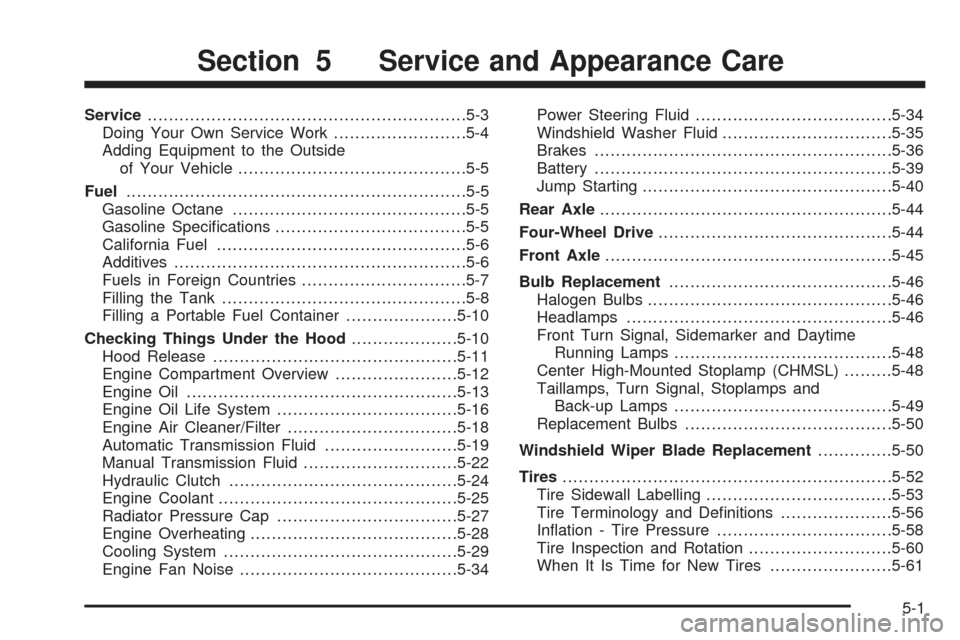
Service............................................................5-3
Doing Your Own Service Work.........................5-4
Adding Equipment to the Outside
of Your Vehicle...........................................5-5
Fuel................................................................5-5
Gasoline Octane............................................5-5
Gasoline Speci�cations....................................5-5
California Fuel...............................................5-6
Additives.......................................................5-6
Fuels in Foreign Countries...............................5-7
Filling the Tank..............................................5-8
Filling a Portable Fuel Container.....................5-10
Checking Things Under the Hood....................5-10
Hood Release..............................................5-11
Engine Compartment Overview.......................5-12
Engine Oil...................................................5-13
Engine Oil Life System..................................5-16
Engine Air Cleaner/Filter................................5-18
Automatic Transmission Fluid.........................5-19
Manual Transmission Fluid.............................5-22
Hydraulic Clutch...........................................5-24
Engine Coolant.............................................5-25
Radiator Pressure Cap..................................5-27
Engine Overheating.......................................5-28
Cooling System............................................5-29
Engine Fan Noise.........................................5-34Power Steering Fluid.....................................5-34
Windshield Washer Fluid................................5-35
Brakes........................................................5-36
Battery........................................................5-39
Jump Starting...............................................5-40
Rear Axle.......................................................5-44
Four-Wheel Drive............................................5-44
Front Axle......................................................5-45
Bulb Replacement..........................................5-46
Halogen Bulbs..............................................5-46
Headlamps..................................................5-46
Front Turn Signal, Sidemarker and Daytime
Running Lamps.........................................5-48
Center High-Mounted Stoplamp (CHMSL).........5-48
Taillamps, Turn Signal, Stoplamps and
Back-up Lamps.........................................5-49
Replacement Bulbs.......................................5-50
Windshield Wiper Blade Replacement..............5-50
Tires..............................................................5-52
Tire Sidewall Labelling...................................5-53
Tire Terminology and De�nitions.....................5-56
In�ation - Tire Pressure.................................5-58
Tire Inspection and Rotation...........................5-60
When It Is Time for New Tires.......................5-61
Section 5 Service and Appearance Care
5-1
Page 277 of 414
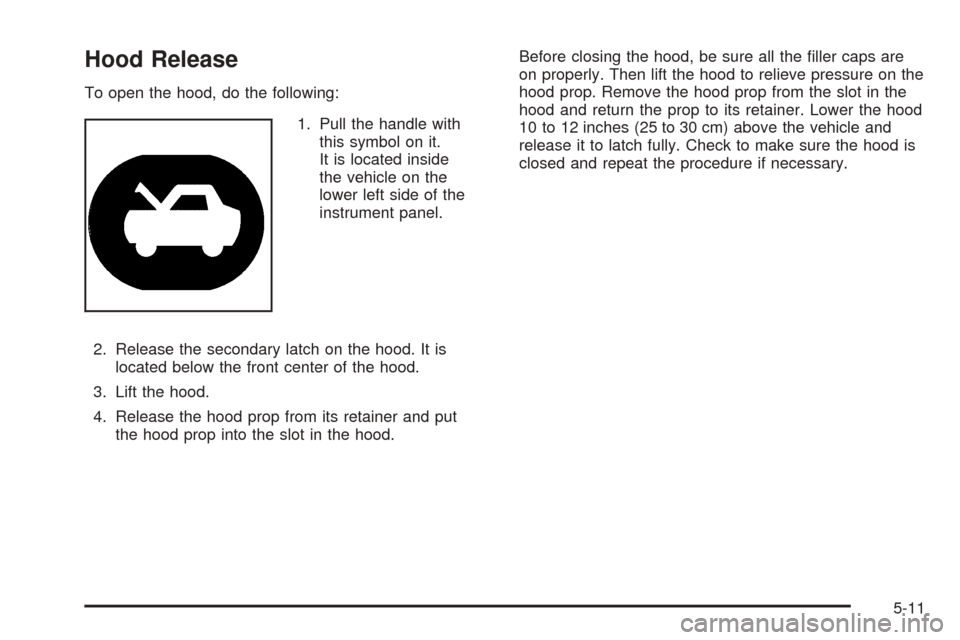
Hood Release
To open the hood, do the following:
1. Pull the handle with
this symbol on it.
It is located inside
the vehicle on the
lower left side of the
instrument panel.
2. Release the secondary latch on the hood. It is
located below the front center of the hood.
3. Lift the hood.
4. Release the hood prop from its retainer and put
the hood prop into the slot in the hood.Before closing the hood, be sure all the �ller caps are
on properly. Then lift the hood to relieve pressure on the
hood prop. Remove the hood prop from the slot in the
hood and return the prop to its retainer. Lower the hood
10 to 12 inches (25 to 30 cm) above the vehicle and
release it to latch fully. Check to make sure the hood is
closed and repeat the procedure if necessary.
5-11
Page 312 of 414
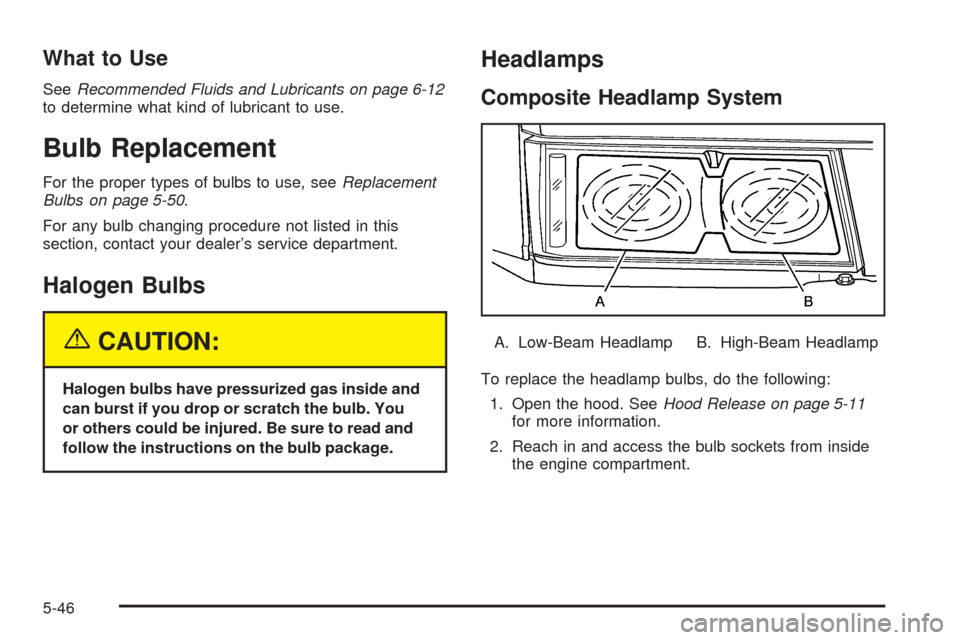
What to Use
SeeRecommended Fluids and Lubricants on page 6-12
to determine what kind of lubricant to use.
Bulb Replacement
For the proper types of bulbs to use, seeReplacement
Bulbs on page 5-50.
For any bulb changing procedure not listed in this
section, contact your dealer’s service department.
Halogen Bulbs
{CAUTION:
Halogen bulbs have pressurized gas inside and
can burst if you drop or scratch the bulb. You
or others could be injured. Be sure to read and
follow the instructions on the bulb package.
Headlamps
Composite Headlamp System
A. Low-Beam Headlamp B. High-Beam Headlamp
To replace the headlamp bulbs, do the following:
1. Open the hood. SeeHood Release on page 5-11
for more information.
2. Reach in and access the bulb sockets from inside
the engine compartment.
5-46
Page 314 of 414
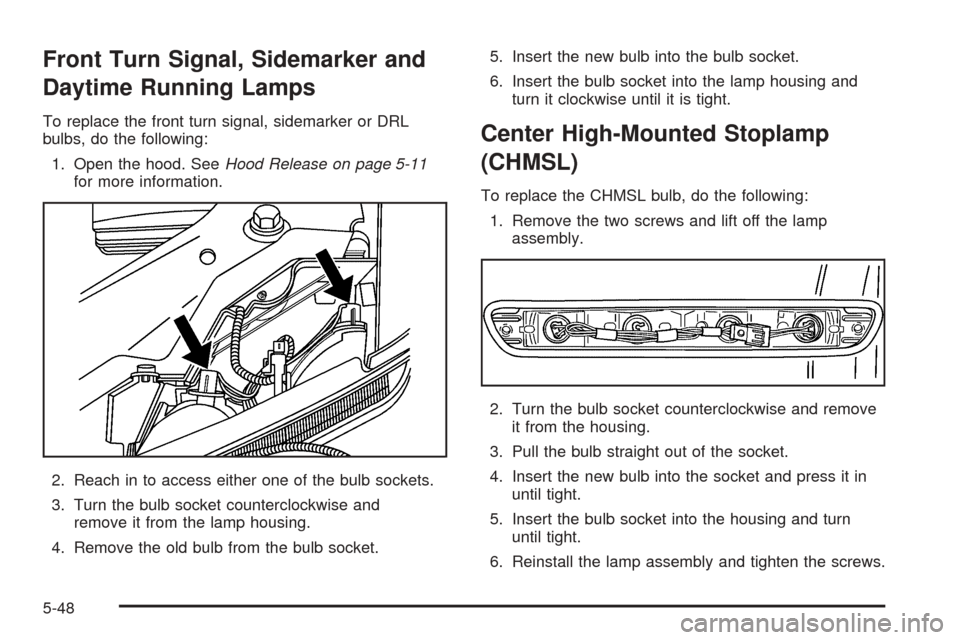
Front Turn Signal, Sidemarker and
Daytime Running Lamps
To replace the front turn signal, sidemarker or DRL
bulbs, do the following:
1. Open the hood. SeeHood Release on page 5-11
for more information.
2. Reach in to access either one of the bulb sockets.
3. Turn the bulb socket counterclockwise and
remove it from the lamp housing.
4. Remove the old bulb from the bulb socket.5. Insert the new bulb into the bulb socket.
6. Insert the bulb socket into the lamp housing and
turn it clockwise until it is tight.Center High-Mounted Stoplamp
(CHMSL)
To replace the CHMSL bulb, do the following:
1. Remove the two screws and lift off the lamp
assembly.
2. Turn the bulb socket counterclockwise and remove
it from the housing.
3. Pull the bulb straight out of the socket.
4. Insert the new bulb into the socket and press it in
until tight.
5. Insert the bulb socket into the housing and turn
until tight.
6. Reinstall the lamp assembly and tighten the screws.
5-48
Page 378 of 414
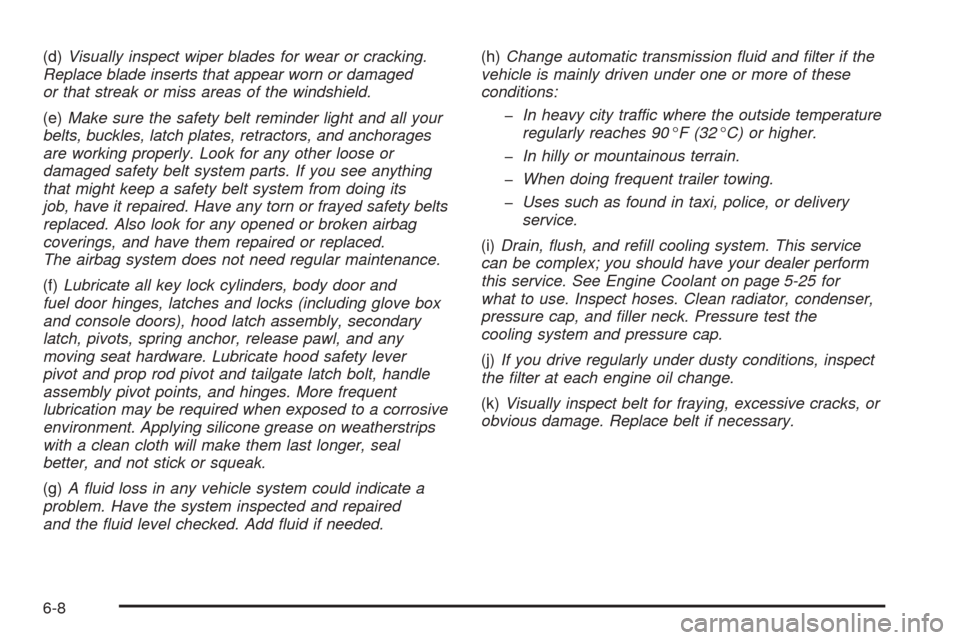
(d)Visually inspect wiper blades for wear or cracking.
Replace blade inserts that appear worn or damaged
or that streak or miss areas of the windshield.
(e)Make sure the safety belt reminder light and all your
belts, buckles, latch plates, retractors, and anchorages
are working properly. Look for any other loose or
damaged safety belt system parts. If you see anything
that might keep a safety belt system from doing its
job, have it repaired. Have any torn or frayed safety belts
replaced. Also look for any opened or broken airbag
coverings, and have them repaired or replaced.
The airbag system does not need regular maintenance.
(f)Lubricate all key lock cylinders, body door and
fuel door hinges, latches and locks (including glove box
and console doors), hood latch assembly, secondary
latch, pivots, spring anchor, release pawl, and any
moving seat hardware. Lubricate hood safety lever
pivot and prop rod pivot and tailgate latch bolt, handle
assembly pivot points, and hinges. More frequent
lubrication may be required when exposed to a corrosive
environment. Applying silicone grease on weatherstrips
with a clean cloth will make them last longer, seal
better, and not stick or squeak.
(g)A �uid loss in any vehicle system could indicate a
problem. Have the system inspected and repaired
and the �uid level checked. Add �uid if needed.(h)Change automatic transmission �uid and �lter if the
vehicle is mainly driven under one or more of these
conditions:
�In heavy city traffic where the outside temperature
regularly reaches 90°F (32°C) or higher.
�In hilly or mountainous terrain.
�When doing frequent trailer towing.
�Uses such as found in taxi, police, or delivery
service.
(i)Drain, �ush, and re�ll cooling system. This service
can be complex; you should have your dealer perform
this service. See Engine Coolant on page 5-25 for
what to use. Inspect hoses. Clean radiator, condenser,
pressure cap, and �ller neck. Pressure test the
cooling system and pressure cap.
(j)If you drive regularly under dusty conditions, inspect
the �lter at each engine oil change.
(k)Visually inspect belt for fraying, excessive cracks, or
obvious damage. Replace belt if necessary.
6-8
Page 383 of 414
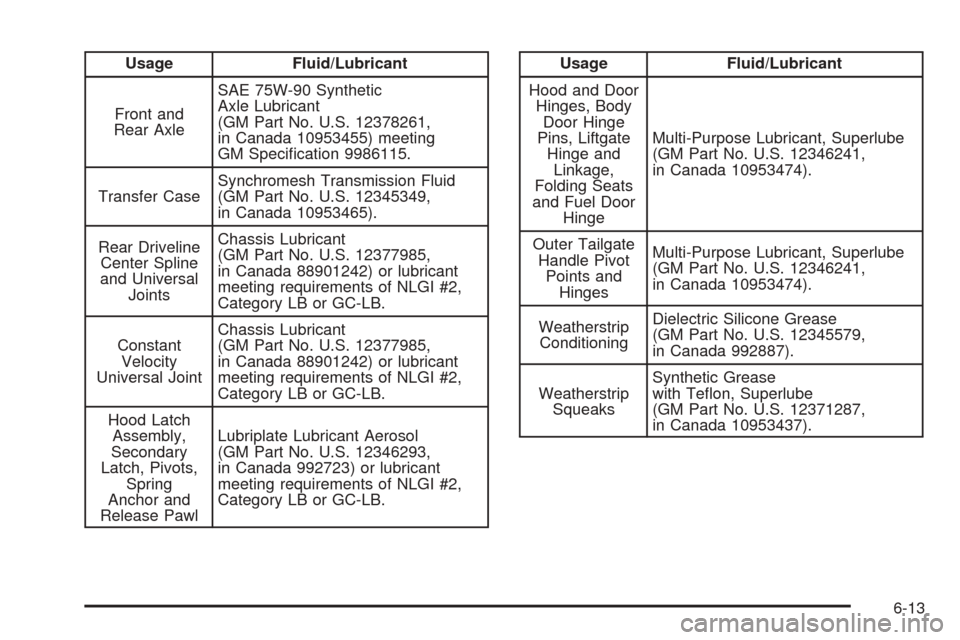
Usage Fluid/Lubricant
Front and
Rear AxleSAE 75W-90 Synthetic
Axle Lubricant
(GM Part No. U.S. 12378261,
in Canada 10953455) meeting
GM Speci�cation 9986115.
Transfer CaseSynchromesh Transmission Fluid
(GM Part No. U.S. 12345349,
in Canada 10953465).
Rear Driveline
Center Spline
and Universal
JointsChassis Lubricant
(GM Part No. U.S. 12377985,
in Canada 88901242) or lubricant
meeting requirements of NLGI #2,
Category LB or GC-LB.
Constant
Velocity
Universal JointChassis Lubricant
(GM Part No. U.S. 12377985,
in Canada 88901242) or lubricant
meeting requirements of NLGI #2,
Category LB or GC-LB.
Hood Latch
Assembly,
Secondary
Latch, Pivots,
Spring
Anchor and
Release PawlLubriplate Lubricant Aerosol
(GM Part No. U.S. 12346293,
in Canada 992723) or lubricant
meeting requirements of NLGI #2,
Category LB or GC-LB.Usage Fluid/Lubricant
Hood and Door
Hinges, Body
Door Hinge
Pins, Liftgate
Hinge and
Linkage,
Folding Seats
and Fuel Door
HingeMulti-Purpose Lubricant, Superlube
(GM Part No. U.S. 12346241,
in Canada 10953474).
Outer Tailgate
Handle Pivot
Points and
HingesMulti-Purpose Lubricant, Superlube
(GM Part No. U.S. 12346241,
in Canada 10953474).
Weatherstrip
ConditioningDielectric Silicone Grease
(GM Part No. U.S. 12345579,
in Canada 992887).
Weatherstrip
SqueaksSynthetic Grease
with Te�on, Superlube
(GM Part No. U.S. 12371287,
in Canada 10953437).
6-13
Page 406 of 414
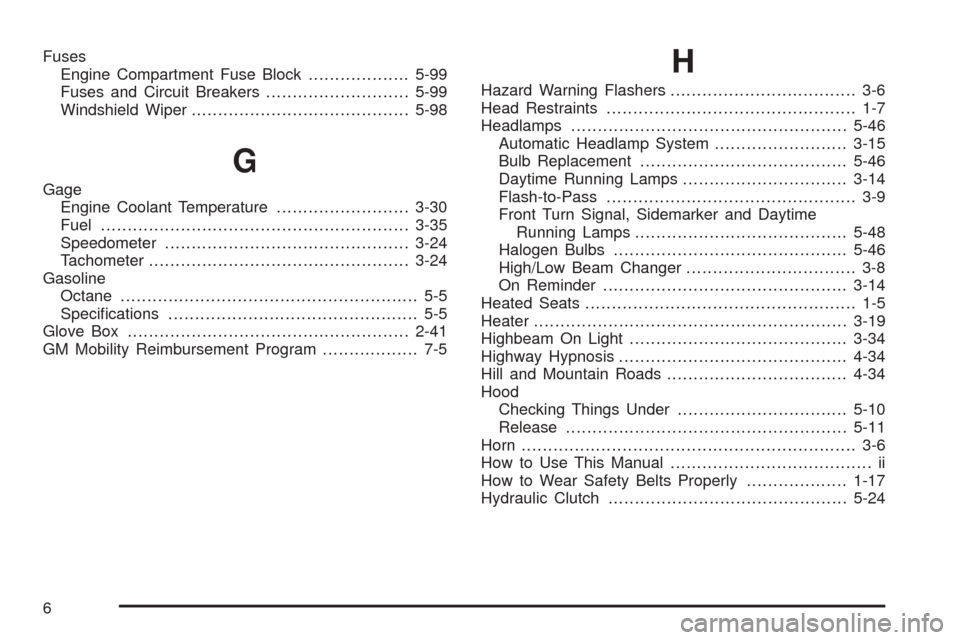
Fuses
Engine Compartment Fuse Block...................5-99
Fuses and Circuit Breakers...........................5-99
Windshield Wiper.........................................5-98
G
Gage
Engine Coolant Temperature.........................3-30
Fuel..........................................................3-35
Speedometer..............................................3-24
Tachometer.................................................3-24
Gasoline
Octane........................................................ 5-5
Speci�cations............................................... 5-5
Glove Box.....................................................2-41
GM Mobility Reimbursement Program.................. 7-5
H
Hazard Warning Flashers................................... 3-6
Head Restraints............................................... 1-7
Headlamps....................................................5-46
Automatic Headlamp System.........................3-15
Bulb Replacement.......................................5-46
Daytime Running Lamps...............................3-14
Flash-to-Pass............................................... 3-9
Front Turn Signal, Sidemarker and Daytime
Running Lamps........................................5-48
Halogen Bulbs............................................5-46
High/Low Beam Changer................................ 3-8
On Reminder..............................................3-14
Heated Seats................................................... 1-5
Heater...........................................................3-19
Highbeam On Light.........................................3-34
Highway Hypnosis...........................................4-34
Hill and Mountain Roads..................................4-34
Hood
Checking Things Under................................5-10
Release.....................................................5-11
Horn............................................................... 3-6
How to Use This Manual...................................... ii
How to Wear Safety Belts Properly...................1-17
Hydraulic Clutch.............................................5-24
6